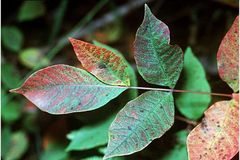Toxicodendron vernix
| Toxicodendron vernix subsp. var. | Poison Sumac, Poison Elder | |||||||||||||||||||||||||||||||||||||||||||||||||||||||
|---|---|---|---|---|---|---|---|---|---|---|---|---|---|---|---|---|---|---|---|---|---|---|---|---|---|---|---|---|---|---|---|---|---|---|---|---|---|---|---|---|---|---|---|---|---|---|---|---|---|---|---|---|---|---|---|---|

|
|
| ||||||||||||||||||||||||||||||||||||||||||||||||||||||
| ||||||||||||||||||||||||||||||||||||||||||||||||||||||||
Poison sumac (Toxicodendron vernix or Rhus vernix) is a woody shrub or small tree growing to 7 m (20 ft) tall.[1] All parts of the plant contain a resin called urushiol that causes skin and mucous membrane irritation to humans. When burned, inhalation of the smoke may cause the rash to appear on the lining of the lungs, causing extreme pain and possibly fatal respiratory difficulty.
Poison sumac is a shrub or small tree, up to 20 feet in height, with 7-13 leaflets per leaf. These are oval to oblong, acuminate, cuneate at the base, undulate, glabrous or slightly pubescent beneath, and are usually 2-4 inch long. Its flowers are greenish, in loose axillary panicles 3-8 inches long. The fruits are subglobose, gray, flattened and 0.2 inches across.
| Standard Cyclopedia of Horticulture |
|---|
|
Rhus vernix, Linn. (R. venenata, DC.). Poison Sumac. Poison Elder. Shrub or tree, to 20 ft.: lfts. 7-13, oval to oblong, acuminate, cuneate at base, undulate, glabrous or slightly pubescent beneath usually 2-4 in. long: fls. greenish, in loose axillary panicles 3-8 in. long: fr. subglobose, gray, flattened, 1/5in. across. Swamps, R. I., Ont., and Minn., south to Fla. and La.—Very poisonous: foliage turns to a brilliant scarlet in autumn.
|
Describe the plant here...
Cultivation
Propagation
Pests and diseases
Species
Gallery
If you have a photo of this plant, please upload it! Plus, there may be other photos available for you to add.
-
photo 1
-
photo 2
-
photo 3
References
- Standard Cyclopedia of Horticulture, by L. H. Bailey, MacMillan Co., 1963
External links
- w:Toxicodendron vernix. Some of the material on this page may be from Wikipedia, under the Creative Commons license.
- Toxicodendron vernix QR Code (Size 50, 100, 200, 500)
- ↑ Our Native Trees and How to Identify Them (Keeler)
